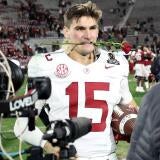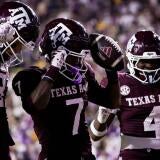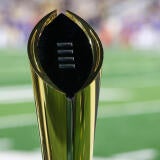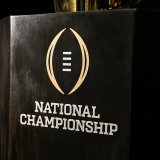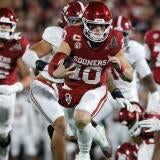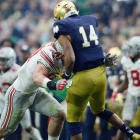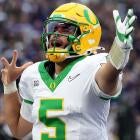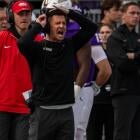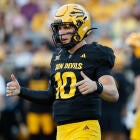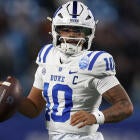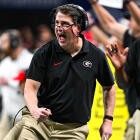College football targeting penalties, ejections may see reductions in 2017
If adjusted rules are passed, targeting calls may be more fair for all involved

College football targeting penalties may become more lenient through a proposed rule change that could result in fewer player ejections.
As targeting ejections have doubled over three years, the NCAA Football Rules Committee is looking at changing the replay standards so a targeting ejection only occurs if the penalty is confirmed. Currently, if replay doesn't have enough evidence to confirm targeting but can't rule it's not targeting, the call on the field stands and the player gets ejected.
NCAA associate director Ty Halpin, the liaison for the rules committee, said ejecting a player is "a pretty expensive deal" if targeting isn't certain. Halpin said the "vast majority" of targeting flags thrown on the field should be confirmed, but there's a fairness issue to consider for players.
"We still want to the official to throw the flag there," Halpin said. "But if replay says there's a little bit of contact on the shoulder and it's more because the player adjusted and it wasn't a dangerous attempt by the player delivering the contact, then maybe that player deserves to stay in the game. It's a reasonable thing to go with."
The Football Bowl Subdivision had 144 targeting ejections during 2016, up from 72 in 2014, according to the NCAA. Replay had new authority in 2016 to call targeting even if a flag wasn't thrown. FBS replay stopped a game 29 times to look for a possible targeting foul, resulting in 16 ejections.
National officiating coordinator Rogers Redding said he is not alarmed by more targeting penalties. He attributed the rise to officials becoming more comfortable making the call, a less narrow definition of targeting, and new players coming in each year who aren't accustomed to the penalty.
"We can still see clear player behavior [changes]," Redding said. "Plays that five years ago we'd be scared to death the guy would be killed, now we see players holding up, getting their head out of the way, wrapping up, doing less of a launch. Even though the [targeting] numbers are up, it's been a positive player behavior impact on the game itself."
American Football Coaches Association executive director Todd Berry said coaches believe the targeting penalty is necessary but are concerned about the consistency of calls.
"There are certainly some that are deserving," Berry said. "But there are also some where the receiver is up in the air and the defensive player doesn't launch, but he's also changing his vertical plane. Where do you gauge hitting that person? That's a tough thing to do instantaneously. Athletically, I don't even know if they're capable of doing that at the college level. Even the NFL guys can't pull that off, either."College football targeting penalties may become more lenient through a proposed rule change that could result in fewer player ejections.
There are two kinds of targeting penalties, as defined by the NCAA rulebook.
1. Targeting and Making Forcible Contact With the Crown of the Helmet: "No player shall target and make forcible contact against an opponent with the crown [top] of his helmet. This foul requires that there be at least one indicator of targeting." All indicators must have forcible contact and include, but aren't limited to, a player launching himself by leaving his feet; a crouch followed by a upward and forward thrust; leading with the helmet, shoulder, forearm, fist, hand or elbow to attack at the head or neck area; lowering the head before attacking with the crown of the helmet.
2. Targeting and Making Forcible Contact to Head or Neck Area of a Defenseless Player: "No player shall target and make forcible contact to the head or neck area of a defenseless opponent with the helmet, forearm, hand, fist, elbow or shoulder. This foul requires there be at least one indicator of targeting." The indicators remain the same as No. 1. Defenseless players can mean various situations for quarterbacks, ball-carriers and kickers when they're deemed unable to protect themselves.
Big 12 officiating coordinator Walt Anderson said there's broad support from conference officiating coordinators to create more fairness for players related to ejections. This is an off year for NCAA rules changes, meaning only rules attached to player safety -- such as targeting -- can be adopted for 2017.
If the proposal with the most support passes at the rules committee meeting on March 2-3, replay officials would have three options when reviewing targeting:
- If replay confirms targeting, the player is still ejected and the 15-yard penalty stands.
- If replay overturns targeting, the player stays in the game and the 15-yard penalty goes away.
- If replay doesn't have enough evidence to confirm targeting or overturn the penalty -- i.e., the call on the field stands -- the player stays in the game and the 15-yard penalty remains.
"This is a part of the evolution of the rule," Redding said.
Last year, the NCAA began requiring replay to review all aspects of targeting penalties, such as whether a player launched himself and the location of contact. Previously, replay could only look at the point of forcible contact or whether the crown of the helmet was used.
The 2016 season was also the first year in which every Power Five conference except the Big 12 experimented with collaborative replay, meaning more eyes reviewing targeting. The Big 12, which will use a command center for collaborative replay in 2017, had the fewest targeting ejections per game among the Power Five in 2016 (0.12).
The SEC had the most targeting ejections overall (26) and per game (0.27) and the fewest calls overturned among the Power Five. "I personally think it's changing player behavior," SEC officiating coordinator Steve Shaw said.
The American Athletic Conference, which will use collaborative replay for the first time in 2017, had the fewest targeting penalties per game (0.1). The AAC was the only conference with more targeting calls overturned by replay than upheld.
Why is there such a discrepancy by conference in targeting penalties?
"I've thought about this a lot," Redding said. "We do see different styles of play in different conferences. Some are more wide open than others. I think in conferences that are dominated by teams that run wide-open spread, faster-pace offense, you're more likely to see more plays run in a game. If there's more plays run, there's more opportunities for fouls. That may be one thing. We haven't analyzed it carefully."
That theory doesn't appear to hold up. Offenses in the Big 12 and the AAC ran the most plays per game in 2016, yet those leagues finished in the bottom three with the Mountain West for targeting penalties per game.
More likely, the discrepancy is due to the complaint often voices by coaches and fans: not enough consistency on targeting calls. The targeting penalty was created in 2008, and ejections became attached in 2013 as the concussion crisis in football became more prevalent.
Given what's at stake -- the ejection of a player and, if the foul occurs in the second half, a first-half suspension for the next game -- the NCAA appears ready to offer some leniency.
Also, overturning a targeting ejection when there's not enough evidence "puts the player on notice that he needs to watch himself the next time around," Redding said. "I think it's going to be helpful from a warning standpoint as well."
Targeting calls by conference, 2016
| Conference | Upheld | Oveturned | Ejections Per Game |
| SEC | 26 | 3 | 0.27 |
| ACC | 18 | 4 | 0.18 |
| Big Ten | 16 | 6 | 0.16 |
| Pac-12 | 16 | 6 | 0.2 |
| C-USA | 14 | 2 | 0.17 |
| MAC | 14 | 7 | 0.19 |
| Sun Belt | 13 | 0 | 0.19 |
| Big 12 | 8 | 6 | 0.12 |
| Mountain West | 8 | 7 | 0.11 |
| AAC | 8 | 9 | 0.1 |
| Independent | 3 | 1 | 0.27 |
| Total | 144 | 51 | 0.17 |
FBS Targeting penalties by year
| Year | Upheld | Overturned | Ejections Per Game |
| 2013 | 31 | 24 | 0.04 |
| 2014 | 72 | 26 | 0.09 |
| 2015 | 115 | 43 | 0.14 |
| 2016 | 144 | 51 | 0.17 |
| Total | 362 | 144 | 0.11 |
All statistics via the NCAA
NCAA pulls back allowing coaches electronic devices
The NCAA Football Rules Committee rescinded a proposal to allow video and electronic devices in coaching booths and locker rooms. The Division I Competition Committee plans to dig into the competitive fairness and costs associated with technology, which college football has struggled to handle.
"Some coaches think it's great, and maybe they've had more experience with it at the NFL level," said Halpin, the NCAA liaison for the rules committee. "Some coaches think that shouldn't be what football is about, and once you're at the game, it should be about making adjustments [without technology] and coaching the team. Finding the right balance has been a bit of a challenge for all of us."
Coaches across the country -- especially in the SEC, where money isn't a problem -- were thinking about how to take advantage of video during games. Arkansas coach Bret Bielema said last spring that electronic devices "might be one of the greatest game changers in college football history."
In October, around when the pending NCAA video rule was scrapped, Tennessee released a Neyland Stadium renovation feasibility study that included an elaborate halftime meeting room. The plans called for an 8,800-square foot room with multiple televisions and whiteboards, plus a wall that could be raised in 30 seconds to separate the offense and defense. In other words, the Vols were about to start a new arms race -- this one for halftime meeting rooms.
"Taking advantage of a pending rule change by the NCAA allowing video to be used at halftime, the Halftime Meeting Room will optimize current technology to provide Tennessee coaches a dramatic advantage over their opponents," the Tennessee study read.
College football is even less permissive with technology than high schools. For several years, the National Federation of State High School Associations has allowed any form of communication technology during football games when outside the nine-yard marks, on the sidelines and during halftime.
NFL playcallers have been able to talk to quarterbacks through their helmets since 1994 and with a defensive player since 2008. The NFL started letting coaches use tablets on the sideline in 2014.
"If you talk to the NFL coaches, they say [increased technology is] the worst thing that ever happened to the game," said Berry, the AFCA executive director. "The NFL has dedicated people, a lot of money and only 32 teams, instead of 128 teams, to try to make sure there's no competitive advantage. If they can't get it right, then why in the world would we think we can get it right? We're not against the concept of it. As soon as the NFL can get it right and find a price point that's effective, we'd probably be more than happy to be engaged in it."
Last year, the NCAA Football Rules Committee initially approved video for coaches upstairs and in the locker rooms for 2016. The NCAA Playing Rules Oversight Panel delayed the rule for one year, but the football rules committee rescinded it in October.
"You don't want your home team to have some incredible technology capability and the visitors not to have any," said Shaw, the SEC officiating coordinator. "There's a cost component to this everybody has to understand. There will be a lot of work around technology for fleshing out what really will be good for the game."


